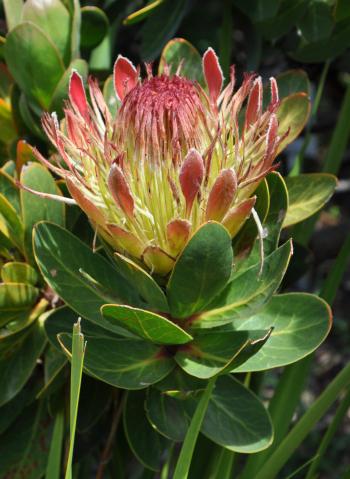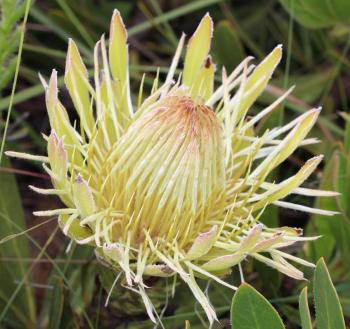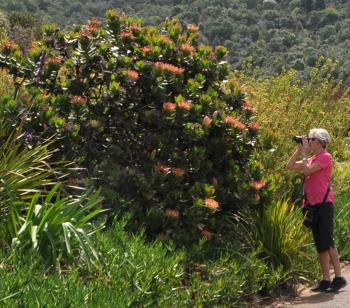Protea roupelliae subsp. hamiltonii
Protea roupelliae Meisn subsp. hamiltonii Beard ex Rourke
Family: Proteaceae
Common names: dwarf silver sugarbush (Eng.); ranksilwersuikerbos (Afr.)
Introduction
A dwarf, procumbent shrub, ideal for a rockery or grassland gardens; it produces many low branches, with the stem spreading horizontally, and magnificent cream and pink flower heads that last for about three months in summer. It’s also a good choice for gardeners in the summer rainfall area that struggle to grow fynbos proteas.

Description
Description
Protea roupelliae subsp. hamiltonii grows up to 0.3 m tall, sprawling to form a low mat of about 1 m in diameter in its natural habitat, although there is an old specimen in the Protea Garden at Kirstenbosch National Botanical Garden, that is about 1 m tall and 2.5 m wide
The leaves are linear-lanceolate to obovate, 80–170 mm long and 15–50 mm wide, with rounded to pointed tips, sclerophyllous (hard and leathery), emerald-green. They can be either hairless or with shaggy to silky hairs.

Proteas in general, produce flowerheads or inflorescences made of many small flowers massed together within a cup of usually coloured floral bracts. The male and female elements are carried in the same flower; the female consists of a stigma and pollen presenter, style and ovary; and the male consists of stamens and anthers. The dwarf silver sugarbush has an oblong-obconic to goblet-shaped flowerhead of 80–120 mm long and 80–100 mm in diameter. The outer series of bracts are always shorter than the inner series of bracts, which are 50–100 mm long and 6–10 mm wide. The inner bracts are pink or ruddy to brown, spoon- or tongue-shaped, with silky hairs, with the tip pointed in the floral bracts cup and can often be widely spaced.
This species flowers in late summer to autumn (February to April). When the flowerheads open, the involucral bracts expose the many individual florets that are green at the bottom and pink toward the tips.
It is similar to Protea roupelliae subsp. roupelliae, the silver sugarbush. These two subspecies differ primarily in their growth form, with the latter forming a small upright tree of about 4–8 m high.

Conservation Status
Status
Protea roupelliae subsp. hamiltonii is a rare species that is assessed as Critically Endangered (CR) on the Red List of South African plants. Three populations were recorded historically, all in Mpumalanga. Two of these populations are now extinct, one of them was in a small reserve in Nelshoogte State Forest and went extinct in 1984, apparently due to mismanagement. The only remaining population is conserved within a reserve area of 26 ha. According to the Red List website, 180 plants were recorded in 2002 and 670 plants counted in 2015. The most recent count of the population revealed under 1 000 mature plants in 2017.
The threats to the only remaining subpopulation, are too infrequent fire for recruitment, afforestation, invasive alien plants causing depletion of the water table, as well as transforming the habitat, alien plants causing acidification which is causing the plants to look sick and produce fewer seeds, canalization and road building altering drainage and availability of water, and overgrazing. Many of these negative impacts are caused by the surrounding commercial pine plantations. The area was fenced in 1985, to prevent the herbivores from feeding on the plants, but the fence was stolen, causing in increase in grazing. However, the fence has been reinstalled and repairs and replacements have been performed since 2003.

Distribution and habitat
Distribution description
Protea roupelliae subsp. hamiltonii grows on Barberton Montane Grassland and Legogote Sour Bushveld, west of Barberton in Mpumalanga. Subspecies hamiltonii occurs in 3 subpopulations of which two are extinct. It is found growing on leached clay on quartzite. The extant population is clumped on a small spur between two valleys and is conserved with another Near Threatened member of the protea family, Leucospermum gerrardii, the soapstone pincushion.

Derivation of name and historical aspects
History
The genus Protea was named by Carl Linnaeus, the father of taxonomy, after Proteus the mythological Greek god, who could see into the future and always spoke the truth. Protea roupelliae subsp. hamiltonii was discovered in 1957 by Dr P.D. Hamilton, a medical practitioner in Barberton. The subspecies was named after him. The specific name roupelliae, was named for Arabella E. Roupell, the artist and author of a flower book that was published in 1849. P. roupelliae subsp. hamiltonii was introduced into cultivation in 1963 by Mrs E.R. Middelmann, and the Kirstenbosch Garden has been cultivating this subspecies ever since.
The Proteaceae family is known for its magnificent flowering plants. It comprises of more than 1 700 species and 80 genera. Most of about 800 species are native to Australia and includes 45 genera. Africa has about 400 species, of which 382 species occur in South Africa, mainly in the winter rainfall area of the southwestern Cape and includes 17 genera. Other species occur in Central and South America, islands east of New Guinea, New Caledonia, Madagascar, Southeast Asia, New Guinea and New Zealand.
Ecology
Ecology
Protea roupelliae subsp. hamiltonii is pollinated by nectar-feeding birds, mostly sunbirds and sugarbirds. The leaves of proteas contain phenolic compounds to discourage browsing by herbivores. When the proteas die or are killed by fire, the serotinous (retained) seed heads open and the seeds fall to the ground and are dispersed further by wind. This serotinony mechanism allows the seeds to remain in the protective bracts of the mother plant, where they are protected from being eaten by insects and rodents, as well as being protected from fire. Only to be released after the fire has passed, thus the ideal time for germination to take place. Protea seeds have a soft, seed coat with hairs that assist dispersal by wind after fire. The seeds of many species of Protea are also dependent on chemical residues left by the smoke during fire, to stimulate germination. The result is that seeds will not germinate unless the fire has passed through and opened up the vegetation, thus removing competition caused by often dense vegetation. Proteas are also known to have specialized roots called proteoid roots, which are very fine and dense and are very efficient at absorbing moisture and nutrition from the often nutrient-poor soils that they grow in.

Uses
Use
Although very seldom seen in cultivation, Protea roupelliae subsp. hamiltonii is ideal for rock gardens or grassland gardens, where it can be used to create a low-growing, woody groundcover, with its sprawling stems. It has attractive erect foliage and produces its handsome pink flowerheads that last for up to 3 months, in late summer.

Growing Protea roupelliae subsp. hamiltonii
Grow
Grow Protea roupelliae subsp. hamiltonii in a sunny position, in well-drained soil. The species thrives in a grassland garden where regular burning is done as part of the management plan. Small seedlings can be protected from intense fire when young, by covering them with an upturned clay planting pot before the fire. However, once the plants are mature, they should be able to withstand a moderate grass fire and this may even stimulate them to flower or grow more vigorously. It is advisable to reduce watering during the dry winter period. It is also suitable for large containers.
The dwarf silver sugarbush is easily propagated by seed, which takes about 3 weeks to germinate. The seed can be sown in the spring and summer growing season, in a well-drained and aerated growing medium, such as coarse sand and fine-milled pine bark.
Place the seedlings under shade net in the nursery until they are ready to be planted into the garden. Prevent the seedlings being exposed to direct sun while they are still small, which can dry out the soil in the nursery bags and can also scorch small seedlings. Keep the soil moist during the hot dry season, by mulching your flower bed about 50 mm thick. The mulch will keep the roots cool, keep moisture to the soil and reduce the growth of weeds. Wood chipping mulch is highly recommended, as it breaks down very slow and also releases small amount of nutrients to the plant. Plants generally flower from their fourth year.
References
- Brown, N.A.C. & Duncan, G.D. 2006. Grow fynbos plants. Kirstenbosch Gardening Series. South African National Biodiversity Institute, Cape Town.
- Duncan, G., Brown, N. & Nurrish, L. 2013. Grow proteas. Kirstenbosch Gardening Series. South African National Biodiversity Institute, Cape Town.
- Koekemoer, M., Steyn, H.M. & Bester, S.P. 2015. Guide to Plant Families of southern Africa. Strelitzia 31. 2nd ed., 2nd print. South African National Biodiversity Institute, Pretoria, South Africa.
- Matthews, L.J. & Zoe Carter (Artist). 1993. Proteas of the world. Auckland, New Zealand.
- Rebelo, A.G. 1995. Proteas of the summer rainfall region. Protea Atlas Project NBI, Cape Town.
- Rebelo, A.G. et al. 2016. Protea roupelliae Meisn. subsp. hamiltonii Beard ex Rourke. National Assessment: Red List of South African plants version 2017.1. Accessed on 2017/07/03
- Rebelo, T. 2000. Proteas of the Cape Peninsula. Protea Atlas Project. National Botanical Institute, Cape Town.
- Rebelo, A.G. 2001. Proteas. A field guide to the proteas of southern Africa, edn 2. Fernwood Press, Vlaeberg, Cape Town.
- Rourke, J.P.1980. The Proteas of Southern Africa by J.P. Rourke. Purnell. Cape Town
- Tarlton, S. 2011. Conservation and propagation of the critically endangered Protea roupelliae subsp. hamiltonii. Unpublished Dissertation, University of the Witwatersrand, Johannesburg.
- Vogts, M. 1989. South Africa’s Proteaceae. Know them and grow them. Struik Publishers, Cape Town.
Credits
Mashudu Nndanduleni
Kirstenbosch National Botanical Garden
August 2017
Acknowledgements: The author thanks Andrew Hankey of the Walter Sisulu National Botanical Garden, for supplying propagation and cultivation information.
Plant Attributes:
Plant Type: Shrub
SA Distribution: Mpumalanga
Soil type: Clay, Loam
Flowering season: Early Summer, Late Summer, Autumn
PH:
Flower colour: Brown, Pink, Cream
Aspect: Full Sun
Gardening skill: Average
Special Features:
Horticultural zones










Rate this article
Article well written and informative
Rate this plant
Is this an interesting plant?
Login to add your Comment
Back to topNot registered yet? Click here to register.